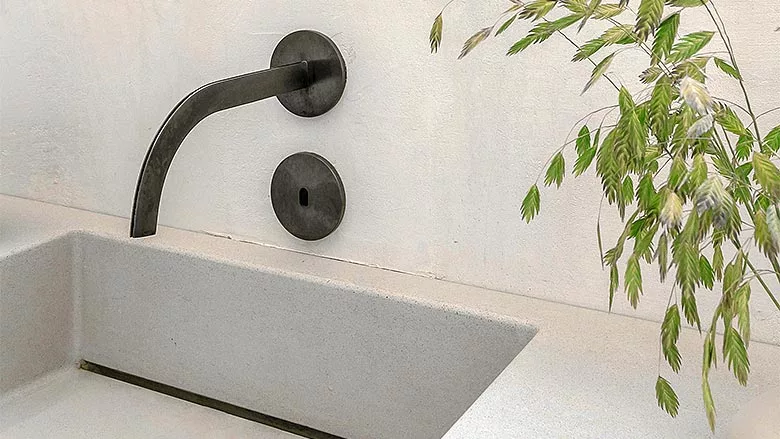CONTRACTOR’S CORNER
Dave Yates: Look Ma, no hands
Plumbers should offer products to enhance customers’ health.

Jevgenija Zukova-Cernova/iStock / Getty Images Plus via Getty Images
We may as well face reality: COVID-19 is here to stay. What a PITA this pandemic has been. As essential workers, you haven’t been given your due. Fearlessly, or not, you have endured two years of fluctuating — often conflicting — information regarding how to remain “safe” from the virus. What the hell?
Now, imagine your customers’ concerns by having you, who have visited many others, in their homes. Intimate encounters, every one, as has always been the case. You breathe, they breathe, and no one can readily tell who’s infected. Stress and anxiety are the new norm it seems.
A good friend Robert Bean, long before the CDC got on board, tagged this as an airborne disease, and those of us who ply the HVAC trades knew he was right. So we upped our game and applied common sense, in spite of officials saying otherwise, and installed, or should I say offered to customers, improvements to safety in air-based heating/cooling systems. Many of you have enhanced your bottom line, deservedly so: Protecting the health of the nation.
As plumbers, what can you do to enhance your customers’ health? That’s a long list, as you already know, but now, you can add infrared residential faucets, if you haven’t already, to your mix of offerings. Aside from the obvious scald-guard protections and elevating potable hot water temperatures to combat evils like Legionella bacteria, proper venting to carry away foul odors and sewer gasses, WaterSense fixtures to conserve natural resources, what remains? Infrared faucets!
In public restrooms, it has been well-known that the most bacteria and virus-laden surfaces are those of flush-valve, toilet and faucet handles. Aversion to touching these surfaces has led to increased needs for cleaning urinal drains. I can state that as fact from decades of experience with the York Galleria Mall serving as a clear example following the installation of infrared flush valves. Prior to their installation, we were auguring out uretic salts and debris every few months. Calcisolve treatments offered a slight reprieve between clogs. Once we installed infrared flush valves, the clogging issues disappeared! The decision to splurge on hands-free faucets was purely based on reducing the ongoing maintenance costs.
Faucets are rapidly becoming available with additional infrared sensors so the user can shift water temperature by moving a hand to one side or the other, and this is true for kitchen faucets.
Australian Norman Wareham is credited with inventing sensor-activated faucets in 1981 with the primary use being for arthritic patients who had great difficulty operating faucet handles. They rapidly became used in hospitals, surgery operating rooms and food prep areas to prevent the spread of bacteria. At the Galleria Mall (and other places where we installed sensor-operated hands-free lavatory faucets), we also installed ASSE-listed thermostatic scald-guard mixing valves and reduced the delivery temperature to 110° F. In our home bathroom where our grandson, who now at 3.5 years old uses the bathroom on his own, the thermostatic scald-guard mixing valve temperature was reduced from 120° to 110°.
Today we are witnessing a trend to install hands-free faucets for both the lavatory and kitchen sinks. While lavatory sink faucets are typically installed with a set delivery temperature in public areas, residential will often see a desire for cold-only usage. At present, that still requires the user to touch the handle to adjust the setting, faucets are rapidly becoming available with additional infrared sensors so the user can shift water temperature by moving a hand to one side or the other, and this is true for kitchen faucets. In both cases, the user can still manually open the faucet by its handle.
The selling points include:
- Top of mind given the pandemic: Hands-free equals no contact transfer of germs, bacteria or viruses;
- Water conservation of up to 70% equals reduced waste of potable (and heat energy) water;
- On average, in residential applications, your customer will see a 3% to 5% reduction in total gallons used. That lowers both the water bill and sewer bill when tied to water usage;
- No worries a child will forget to turn off the faucet because it turns off automatically when hands are removed (unless manually operated); and
- No electricity — no problem as battery life lasts, on average, two years.
When it comes to the kitchen faucet, you have the option of hard-wiring or battery power. For line voltage power, you can tap onto the dishwasher junction box and run power to a surface-mounted receptacle inside the sink cabinet that is GFCI protected, or, if required, an electrician can provide that service. That said, wouldn’t it be less expensive to just go with a battery-powered model? Most have battery packs that can be remotely mounted to facilitate easy replacements of batteries.
So exactly how do these hands-free faucets work? A small infrared light is next to the sensor and when the sensor “sees” the infrared light reflected back, it activates the solenoid. We started installing infrared hands-free faucets way back in the 1990s and never once experienced any failures. Those early models did have one significant issue in that the sensor would sometimes not recognize dark skin. The technology was upgraded, and that became a non-issue. With flush valves, we sometimes had issues with the sensor range adjustment because of a bounce-back off of the stall door causing occasional nuisance flushing.
This presents another opportunity to include plumbing in your service contracts with “free” batteries included! You can add proper cleaning of the sensor surfaces and private label your spray bottle.
Looking for a reprint of this article?
From high-res PDFs to custom plaques, order your copy today!







